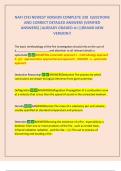NAFI CFEI NEWEST VERSION COMPLETE 230 QUESTIONS
AND CORRECT DETAILED ANSWERS (VERIFIED
ANSWERS) |ALREADY GRADED A+||BRAND NEW
VERSION!!
The basic methodology of the fire investigation should rely on the use of
a______________________and attention to all relevant details a
systematic ANSWERSa systematic approach c . methodology approach
d . g b . approximation approacheneral approach - ANSWER - a . systematic
approach
Deductive Reasoning- ANSWERSDeductive The process by which
conclusions are drawn by logical inference from given premises
Deflagration ANSWERSDeflagration Propagation of a combustion zone
at a velocity that is less than the speed of sound in the unreacted medium .
Density ANSWERSDensity The mass of a substance per unit volume ,
usually specified at standard temperature and pressure
Detection ANSWERSSensing the existence of a fire , especially by a
detector from one or more products of the fire , such as smoke heat ,
infrared radiation radiation , and the like . ( 2 ) The act or process of
discovering and locating a fire .
,Detonation ANSWERSPropagation of a combustion zone at a velocity
greater than the speed of sound in the unreacted medium ..
Diffuse Fuel ANSWERSA gas , vapor , dust , particulate , aerosol , mist ,
fog , or hybrid mixture of these , suspended in the atmosphere , which is
capable of being ignited and propagating a flame front .
Diffusion Flame ANSWERSA flame in which fuel and air mix together at
the region of combustion
Drop Down ANSWERSThe spread of fire by the dropping or falling of
burning . materials
Effective Fire Temperatures ANSWERSEffective Temperatures reached
in fires that produce physical effects that can be related to specific
temperatures
Electric Spark ANSWERSA small , incandescent particle created by
some arcs .
Empirical Data ANSWERSFactual data that is based on actual
measurement , observation or direct sensory experience rather than on
theory .
Energy ANSWERSA property of matter manifested as an ability to
perform work by moving an object against a force or by transferring heat .
,Entrainment ANSWERSThe process of air or gases being drawn into a
fire , plume or jet
Explosible ANSWERSA material with a pressure ratio ( maximum
pressure / pressure at ignition , in absolute units ) equal to or greater than
2.0 in any test when tested using the explosibility or Go / No - Go screening
test described in Section 13 of ASTM E1226 , Standard Test Method for
Explosibility of Dust Clouds . )
Explosion ANSWERSenergy ( chemical or of gases under pressure , or
the mechanical work such as moving , changing , or release of gas under
pressure . These mechanical ) into kinetic energy with the production and
release The sudden conversion of potential high - pressure gases then do
shattering nearby materials .
Explosion Dynamics ANSWERSStudy of how chemistry physics fire
engineering disciplines of fluid and solid mechanics and heat transfer
interact to science influence explosion behavior
Explosive ANSWERSAny chemical compound , mixture , or device that
functions by explosion
Explosive Material ANSWERSAny material that can act as fuel for an
explosion .
, Exposed Surface ANSWERSThe side of a structural assembly or object
that is directly exposed to the fire .
Extinguish ANSWERSTo cause to cease burning .
Failure ANSWERSDistortion , breakage , deterioration , or other fault in
an item , component , system assembly , or structure that results in
unsatisfactory performance of the function for which it was designed .
Failure Analysis ANSWERSA logical , systematic examination of an item
, component , assembly , or structure and its place and function within a
system , conducted in order to identify and analyze the probability , causes ,
and consequences of potential and real failures .
Fall Down ANSWERSThe spread of fire by the dropping or falling of
burning materials .
Finish Rating ANSWERSThe time in minutes , determined under
specific laboratory conditions , at which the stud or joist in contact with the
exposed protective membrane in a protected combustible assembly reaches
an average temperature rise of 121 degrees Celsius ( 250 degrees Fahrenheit
) or an individual temperature rise of 163 degrees Celsius ( 325 degrees
Fahrenheit ) as measured behind the protective membrane nearest the fire
on the plane of the wood .
Fire ANSWERSA rapid oxidation process , which is a chemical reaction
resulting in the evolution of light and heat in varying intensities .




